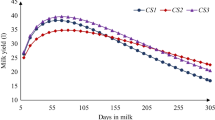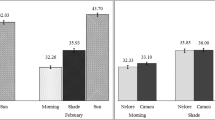Abstract
We compared diurnal patterns of vaginal temperature in lactating cows under grazing conditions to evaluate genotype effects on body temperature regulation. Genotypes evaluated were Holstein, Jersey, Jersey × Holstein and Swedish Red × Holstein. The comparison of Holstein and Jersey versus Jersey × Holstein provided a test of whether heterosis effects body temperature regulation. Cows were fitted with intravaginal temperature recording devices that measured vaginal temperature every 15 min for 7 days. Vaginal temperature was affected by time of day (P < 0.0001) and genotype × time (P < 0.0001) regardless of whether days in milk and milk yield were used as covariates. Additional analyses indicated that the Swedish Red × Holstein had a different pattern of vaginal temperatures than the other three genotypes (Swedish Red × Holstein vs others × time; P < 0.0001) and that Holstein and Jersey had a different pattern than Jersey × Holstein [(Holstein + Jersey vs Jersey × Holstein) × time, P < 0.0001]. However, Holstein had a similar pattern to Jersey [(Holstein vs Jersey) × time, P > 0.10]. These genotype × time interactions reflect two effects. First, Swedish Red × Holstein had higher vaginal temperatures than the other genotypes in the late morning and afternoon but not after the evening milking. Secondly, Jersey × Holstein had lower vaginal temperatures than other genotypes in the late morning and afternoon and again in the late night and early morning. Results point out that there are effects of specific genotypes and evidence for heterosis on regulation of body temperature of lactating cows maintained under grazing conditions and suggest that genetic improvement for thermotolerance through breed choice or genetic selection is possible.


Similar content being viewed by others
References
Berman A, Folman Y, Kaim M, Mamen M, Herz Z, Wolfenson D, Arieli A, Graber Y (1985) Upper critical temperatures and forced ventilation effects for high-yielding dairy cows in a subtropical climate. J Dairy Sci 68:1488–1495
Correa-Calderón A, Armstrong D, Ray D, DeNise S, Enns M, Howison C (2004) Thermoregulatory responses of Holstein and Brown Swiss heat stressed dairy cows to two different cooling systems. Int J Biometeorol 48:142–148. doi:10.1007/s00484-003-0194-y
Dikmen S, Hansen PJ (2009) Is the Temperature-Humidity Index the best indicator of heat stress in lactating dairy cows in a subtropical environment? J Dairy Sci (in press)
Dikmen S, Alava E, Pontes E, Fear JM, Dikmen YK, Olson TA, Hansen PJ (2008) Differences in thermoregulatory ability between slick-haired and wild-type lactating Holstein cows in response to acute heat stress. J Dairy Sci 91:3395–3402. doi:10.3168/jds.2008-1072
Garcia-Peniche TB, Cassell BG, Pearson RE, Misztal I (2005) Comparisons of Holsteins with Brown Swiss and Jersey Cows on the same farm for age at first calving and first calving interval. J Dairy Sci 88:790–796
Hansen PJ (2007) Exploitation of genetic and physiological determinants of embryonic resistance to elevated temperature to improve embryonic survival in dairy cattle during heat stress. Theriogenology 68S:S242–S249. doi:10.1016/j.theriogenology.2007.04.008
Heins BJ, Hansen LB, Seykora AJ (2006) Fertility and survival of pure Holsteins versus crossbreds of Holstein with Normande, Montbeliarde, and Scandinavian Red. J Dairy Sci 89:4944–4951
Madalena FE, Lemos AM, Teodoro RL, Barbosa RT, Monteiro JBN (1990) Dairy production and reproduction in Holstein-Friesian and Guzera crosses. J Dairy Sci 73:1872–1886
McDowell RE, Wilk JC, Talbott CW (1996) Economic viability of crosses of Bos taurus and Bos indicus for dairying in warm climates. J Dairy Sci 79:1292–1303
Olson TA, Lucena C, Chase CC Jr, Hammond AC (2003) Evidence of a major gene influencing hair length and heat tolerance in Bos taurus cattle. J Anim Sci 81:80–90
Oseni S, Misztal I, Tsuruta S, Rekaya R (2003) Seasonality of days open in US Holsteins. J Dairy Sci 86:3718–3725
Ravagnolo O, Misztal I (2000) Genetic component of heat stress in dairy cattle, parameter estimation. J Dairy Sci 83:2126–2130
Ravagnolo O, Misztal I (2002) Effect of heat stress on nonreturn rate in Holstein cows: genetic analyses. J Dairy Sci 85:3092–3100
Ruvuna F, McDaniel BT, McDowell RE, Johnson JC Jr, Hollon BT, Brandt GW (1983) Crossbred and purebred dairy cattle in warm and cool seasons. J Dairy Sci 66:2408–2417
Sørensen MK, Norberg E, Pedersen J, Christensen LG (2008) Invited review: crossbreeding in dairy cattle: a Danish perspective. J Dairy Sci 91:4116–4128. doi:10.3168/jds.2008-1273
West JW (1999) Nutritional strategies for managing the heat-stressed dairy cow. J Anim Sci 77(Suppl 2):21–35
Acknowledgements
Dr. Serdal Dikmen was supported by a grant from TUBITAK-BIDEB Ankara, Turkey. The authors thank to Eduardo Alava from University of Florida for his assistance in data collection; Ron St. John and the employees of Piedmont Dairy for access to their cows and active participation in the experiments, and Pfizer Animal Health for donating blank CIDR devices.
Author information
Authors and Affiliations
Corresponding author
Rights and permissions
About this article
Cite this article
Dikmen, S., Martins, L., Pontes, E. et al. Genotype effects on body temperature in dairy cows under grazing conditions in a hot climate including evidence for heterosis. Int J Biometeorol 53, 327–331 (2009). https://doi.org/10.1007/s00484-009-0218-3
Received:
Revised:
Accepted:
Published:
Issue Date:
DOI: https://doi.org/10.1007/s00484-009-0218-3




